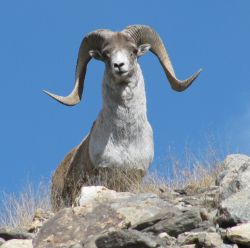COP10 Outcome: Argali Mountain Sheep under CMS Protection
 Bonn,
Bonn,
20 January 2012 - Following the proposal of Tajikistan
and Kazakhstan, the Argali mountain sheep (Ovis ammon) was
listed on CMS Appendix II at COP10 (20-25 November 2011).
The Argali is a threatened migratory mountain ungulate inhabiting
mountains, steppe valleys and rocky outcrops in Central
Asia. The transboundary populations in mountainous frontier
regions between Afghanistan, China, Kazakhstan, Kyrgyzstan,
Tajikistan, Pakistan and Uzbekistan suffer from grazing
pressure, habitat loss and excessive poaching that have
caused dramatic declines in many local populations.
The species is already listed on CITES
Appendix II as it is hunted for subsistence and increasingly
for its horns, which are being used in traditional Chinese
medicine and are internationally traded as hunting trophies.
In addition, little is known about the cross-border migration
routes and critical habitat sites. Border infrastructure
and fences present serious barriers to the animals’
migration. Argali live over a vast geographic range across
the territory of eleven states, which all have very different
management and monitoring approaches. With the Appendix
II listing of the species, CMS Parties are encouraged to
fill gaps in knowledge and address threats urgently, in
order to develop and implement effective measures to conserve
and sustainably manage the species.
Key areas for cooperation include joint
and simultaneous population surveys using standardized methods
for data collection and processing, information sharing,
measures to avoid negative impacts of border fences on migration,
coordination of conservation and hunting approaches as well
as harmonized border controls and management plans. Improved
transboundary cooperation is urgently needed to coordinate
and institutionalize effective management of this migratory
species and its habitat, the mighty yet very vulnerable
mountain ecosystems of Central Asia.
For further information, see the listing
proposal by clicking here.
Last updated on 16 June 2014


